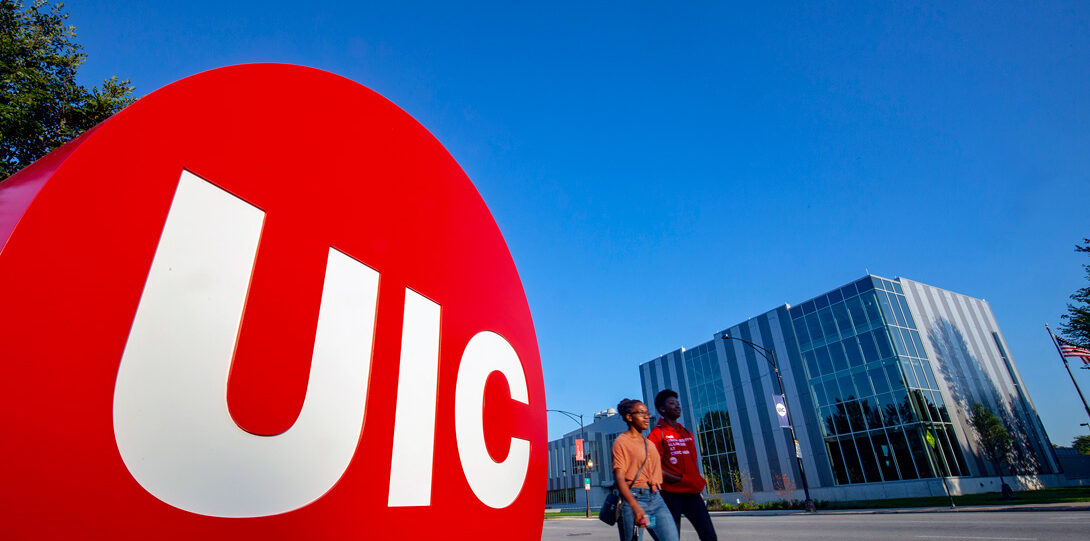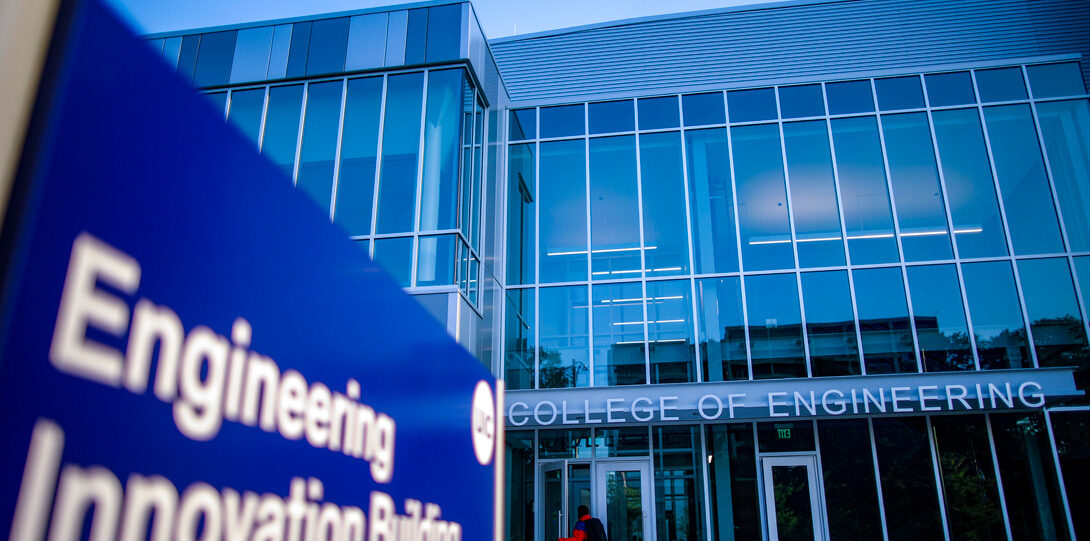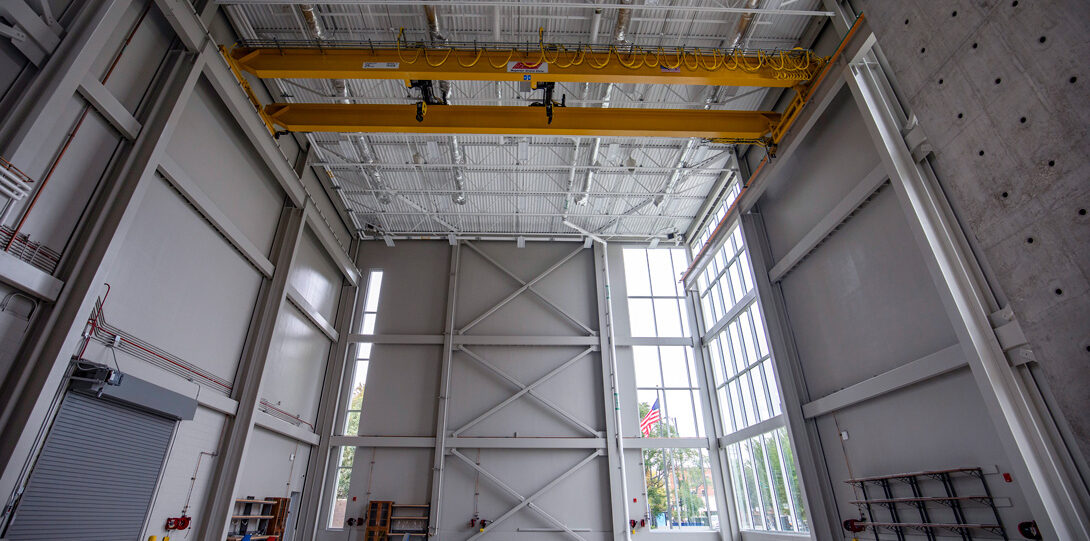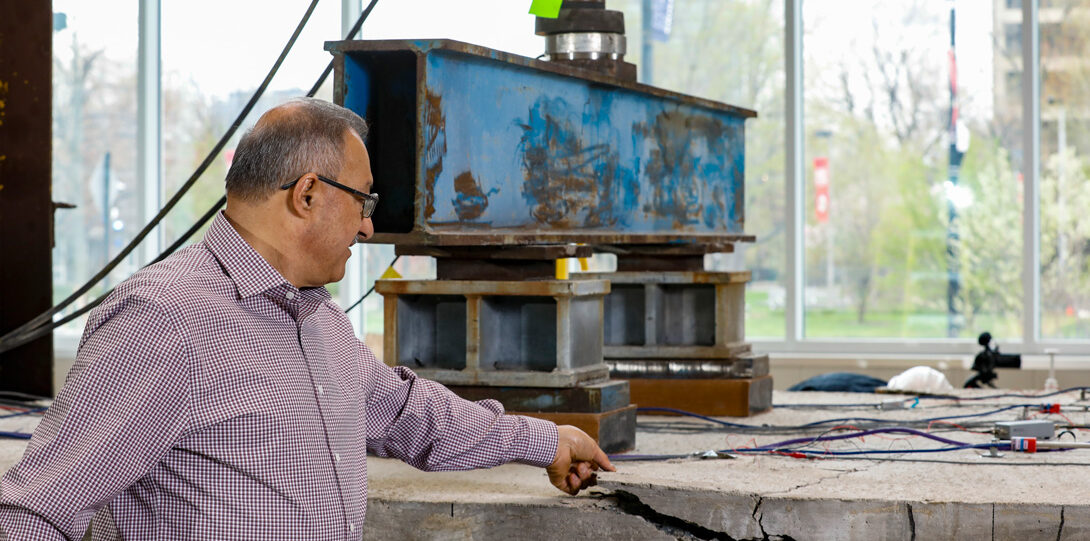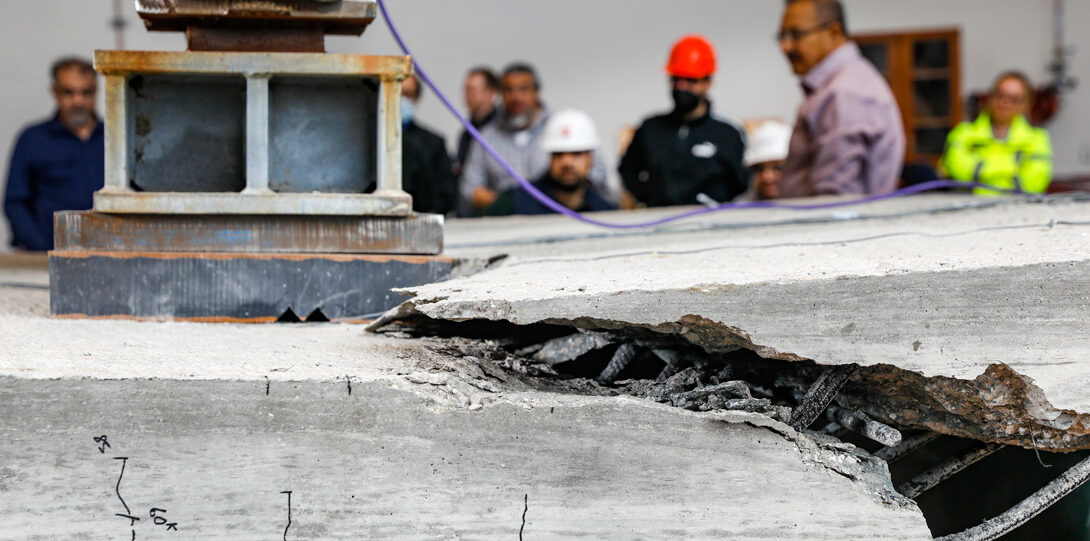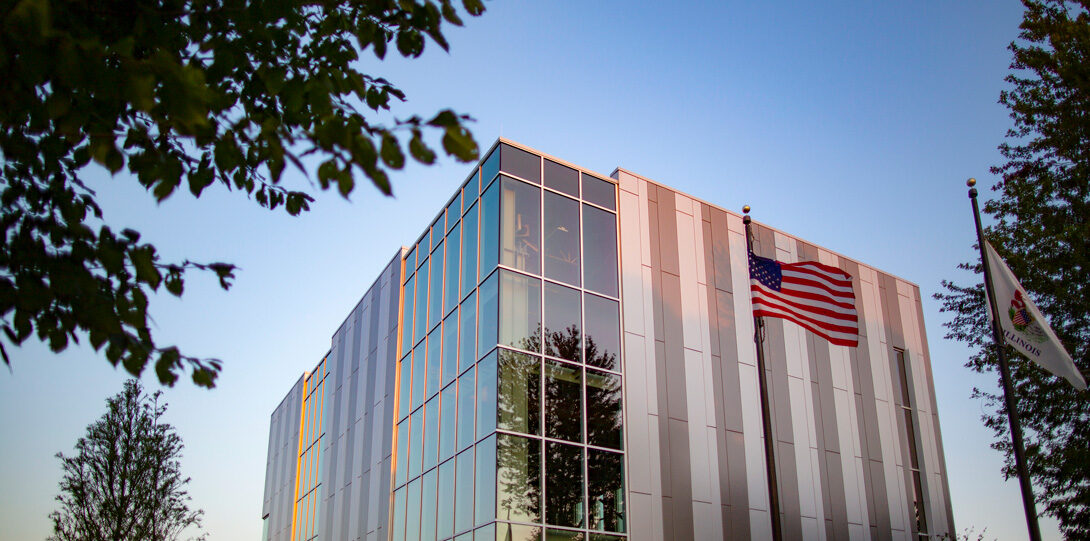High-Bay Structures Laboratory
Engineers face a time of extraordinary opportunity—and significant need—with regard to infrastructure. According to the most recent report card issued by the American Society of Civil Engineers, more than a third of the 600,000 bridges in the United States are more than 50 years old. About 32 percent of urban roads and 14 percent of rural roads are in poor condition. Our network of water pipes is aging.
UIC will contribute to improvements by uniting renowned researchers, energetic students, and forward-thinking companies and agencies in our laboratory, which:
- Offers unique faculty-developed damage-detection sensors that can generate big data on structural degradation and real-time 3D immersive visualization;
- Allows us to monitor key elements of structural health, such as fiber-optic strain and acoustic emission;
- Sets the stage for UIC to be first in developing revolutionary new materials, such as metamaterials that allow new structural designs for buildings and bridges;
- Is the Chicago area's only high-bay structural testing laboratory.
About the Lab
General specs
- 6,000 square feet
- 45-foot high ceiling
- 30-foot high L-shaped strong wall
- 5-foot 6-inch thick strong floor
- Large overhead doors to accommodate delivery of large specimens and components
Primary objectives
- Design and test resilient, energy efficient, reliable infrastructure
- Extend the life of existing infrastructure
- Explore innovative new infrastructure materials
Contact:
Lesley Sneed, PhD
Director, High Bay Structures Laboratory
Professor in Civil, Materials, and Environmental Engineering
(312) 413-3380
lhsneed@uic.edu
Equipment and Systems
The civil, materials, and environmental engineering department is now building out the High-Bay Structures Laboratory with the equipment, systems, and features needed to meet the requirements of the industry and agency partners, faculty, and students who conduct tests in the facility. Expand the section below to see the full list.
1
Major Equipment
- Main hydraulic pump (180 gpm @ 3000 psi) with ports located around the perimeter of the lab
- Closed loop servo-hydraulic fatigue-rated hydraulic actuators with load capacity of 220 kips and displacement capacity of 20 inches (42 actuators)
- Other closed loop servo-hydraulic actuators (various capacities)
- Computerized control systems to control the actuators
- Data acquisition systems to record experimental data from extensive measurement devices
- Universal compression/tension testing machines with various load capacities
Structural Systems for Testing:
- Structural steel frames for small to medium to full scale testing
- Structural steel spreader beams
- Hydraulic cylinders with load capacity ranging from 25 kips to 500 kips
- Hydraulic cylinders with displacement capacity ranging from 6 to 20 inches
- 10,000 psi hydraulic pump and hoses for static load applications
- Electronic data acquisition system
- Load cells for load measurements
- LVDTs for deflection measurements
- Frequency instruments
- Panel concrete mixer up to 15 cubic feet
- Overhead crane (25 ton capacity)
- Fork truck (8000 lb capacity)
- Scissor lift
The High-Bay Lab and UIC
Benefits to UIC Students
The laboratory opens the door to new elements of the civil, materials, and environmental engineering curriculum, including:
- New courses, including Experiment-Based Structural Design, Structural Inspection with Unmanned Aerial Vehicles, and Forensic Engineering
- A new project-based learning class at the graduate level called Civil Engineering Claims and Disputes, in which students will learn about design deficiencies, structural and material flaws, QC/QA practices, and claims and disputes
- New experimental data to enhance case studies taught in courses such as Nondestructive Evaluation of Concrete Structures, Fracture Mechanics and Failure Analysis, Introduction to Data Science, and Cities and Sustainable Infrastructure
- Space to test student work, such as the ASCE steel bridge and concrete canoe
- Video recording of experiments so that students can visualize structural behavior and failure, illustrating the theory they learn in the classroom
Advances in Research and Discovery
The lab allows our faculty to compete for national grants involving large-scale structural testing. Research examples include:
- Testing new types of metabraces to absorb seismic loads
- Conducting impact and penetration tests for structural components and earthen materials
- Testing decommissioned elements of Chicago’s antiquated infrastructure
- Exploring the use of new structural materials to enhance sustainability and resiliency
- Optimizing bridge connections using additively manufactured lattices
Faculty Research
Expand the section below to see how faculty expertise will interface with the capabilities of the lab.
1
Structural Design for Resilient and Smart Infrastructure
- Concrete structures and materials (Mohsen Issa, Farhad Ansari, Lesley Sneed)
- Steel structures (Mustafa Mahamid, Didem Ozevin)
- Masonry and wood (CLT) structures; fire (Mustafa Mahamid)
- FRP structures and reinforcement (Mohsen Issa, Lesley Sneed)
- Structural strengthening and repair (Lesley Sneed)
- Forensic evaluation of structural failures (Hossein Ataei)
- Pipelines (Didem Ozevin)
Structural Mechanics
- Numerical modeling – geomechanics (Craig Foster)
- Mesh free finite element modeling (Sheng-Wei Chi)
- Mechanical metamaterials (Eduard Karpov)
Materials
- Elastic metamaterials (Eduard Karpov, Didem Ozevin)
- Nanomaterials (Matthew Daly)
- Corrosion, metallography (Ernesto Indacochea)
- Ceramics, coatings (Michael McNallan)
Structural Health Monitoring and Nondestructive Testing
- Fiber optic sensors and systems (Farhad Ansari)
- Acoustic emission, ultrasonics (Didem Ozevin)
- Nonlinear ultrasonic modeling (Sheng-Wei Chi)
- Ground penetrating radar (Lesley Sneed)
Sponsorship Opportunities
This $15-million lab will be a cornerstone of the UIC educational experience and a catalyst for faculty research. We seek financial support from industry leaders as we outfit it into a facility that serves students and aligns with industry needs. Premier corporate partners receive premium recognition and engagement opportunities, including the following:
- Name recognition in the lab space, on the laboratory website, and in printed materials
- Invitations to observe experiments and other lab activities
- Opportunities to recruit undergraduate and graduate students
For more information, contact:
Jason Elliott
Executive Director of Development
UIC College of Engineering
312-996-2168
jellio6@uic.edu
